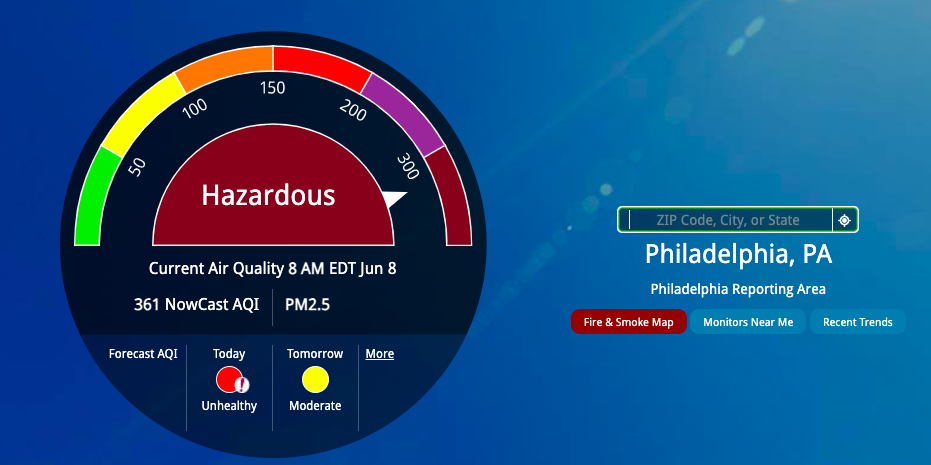
Canadian wildfires lead to “Hazardous” Air Quality in Philadelphia: What you need to know
Climate change is contributing to more droughts, wildfires, and air pollution in the Northeast
A thick, dusty haze of smog has enveloped Philadelphia for the third day in a row, as wildfires continue to rage through the northeast Canadian provinces of Quebec and Nova Scotia.
What’s been happening with the air quality in Philadelphia?
The Pennsylvania Department of Environmental Protection officially declared Wednesday a Code Red Air Quality Action Day for Philadelphia yesterday morning. On Thursday morning, Philadelphia’s air quality index (AQI) registered at 367 after hovering in the 200s on Wednesday – officially reaching “hazardous” levels of small partical pollution. “Good” air quality is between 0 and 50, while anything over 200 is considered “very unhealthy.”

What does this mean for you?
The alert means that all members of the general public may experience mild health effects from the current air quality. Sensitive groups — the elderly, children, as well as those with respiratory or heart conditions — could experience more serious effects.
The Philadelphia Department of Public Health is advising all residents to avoid going outdoors “as much as possible” and to close all windows. (Green Philly postponed its 15-year soirée due to the climate conditions, scheduled for Wednesday night.) To prevent contributing to the poor air, the health department also recommends avoiding “unnecessary” car trips. If you must go outdoors, you’re advised to wear a “high-quality mask, like an N-95 or KN-95.
“We’re encouraging folks to stay inside, and organizers should seriously start considering canceling events and outdoor gatherings,” said health department spokesperson James Garrow in an interview on Wednesday.
How are these wildfires connected to climate change?
More than 100 wildfires are burning across the Canadian border. The event is unusual for the Northeast, where conditions are normally considered too “wet” for extreme fire behavior, says Jane Clougherty, MSc, ScD, a professor of environmental and occupational health at Drexel University, who studies the health effects of air pollution exposures.
“Nova Scotia is not a place that is known for having wildfires, nor is it a climate where we would expect a lot of wildfire activity,” Clougherty said. “And this early in the season, conditions are not usually this dry.”
But as climate change primes the Northeast for more frequent droughts, it is likely that wildfires in the region will become more commonplace. With just .24 inches of rain measured last month, Philadelphia experienced its driest May on record.
“This is a very unusual event, but it certainly is, unfortunately, indicative of the types of wildfire events we may be seeing more of in the future,” Clougherty said.
She spoke to Green Philly on Wednesday about the harms of wildfire smoke and what Philadelphians can do to protect themselves.

It is Wednesday, and Philadelphia PM2.5 concentration is currently 128 micrograms per cubic meter (µg/m³) — 10 times the Environmental Protection Agency’s standard levels of 12.0 µg/m3. What is PM2.5, and why is it so harmful?
PM2.5 is a fine particulate matter, or air pollutant, that is smaller than 2.5 microns in width —that’s a technical way of saying very, very tiny. These particles are particularly dangerous, because they are small enough to travel deep into the respiratory tract, into the alveoli at the base of the lung, and even into the bloodstream.
What are the short- and long-term effects of PM2.5 exposure?
Studies have linked exposure to high concentrations of PM2.5 to aggravated asthma, heart attacks, or even premature death in people with heart or lung disease. Clougherty says that healthy adults likely will only experience mild effects from being outdoors today, including symptoms like a scratchy throat, cough, nausea, or headaches.
However, chronic exposure to high concentrations of PM2.5 has been shown to “contribute to the development of cardiovascular and respiratory disease and a wide range of other health outcomes over time,” she added.

How can Philadelphians protect themselves during this air quality event? Do masks work?
Residents — especially those in the higher-risk category — should stay indoors as much as possible and take steps to reduce their exposure to particle pollution levels while they remain high.
Running an air purifier with a HEPA filter and air conditioners can help, though Clougherty notes that you should make sure your air conditioner filter is clean, to avoid pushing dirty air into your home. Avoid using an air cleaner that works by generating ozone, which will also increase the pollution in your home, she says.
If you must go outside, wear an N95 or KN95 mask, which are able to keep you from inhaling very small particles in your lungs, and stay away from high-traffic areas.

Photo: Lauren Ingeno
What kind of measures could the city take to improve the air quality?
“One of the biggest sources of air pollution in most American cities is indeed traffic,” Clougherty said, “so, everything we can do to reduce reliance on motor vehicles to encourage people to use other forms of transportation would absolutely help to improve air quality.”
A temporary ban on driving in certain areas of the city could have an immediate benefit on air quality, though Garrow, of Philadelphia’s health department, said it’s not a measure the city is currently considering. “In response to a public health emergency, we’ve closed the city down in the past, so I don’t think it’s beyond the realm of possibility — but it’s a massive step,” Garrow said. “We would really be guided by whatever particular situation comes along. It’s not a decision we take lightly.”
How long is this smog going to last? When will I know that the conditions are better?
It’s hard to say. According to NOAA forecasting, the wildfire smoke will become more diffuse by Thursday afternoon, and the air quality should start to improve. Some local experts are predicting this air quality may last into the weekend.
To track air quality in your area, visit airnow.gov.





